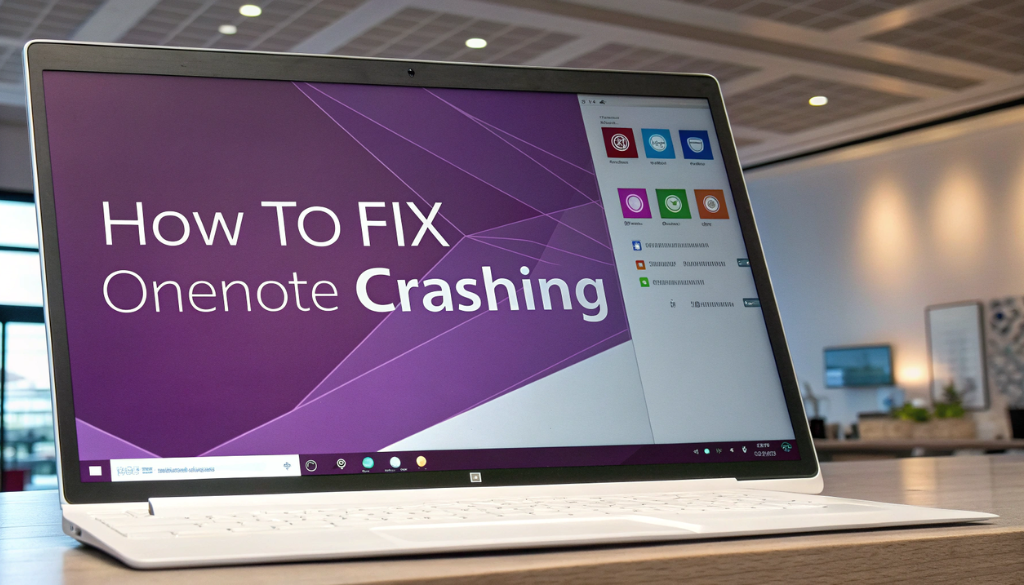Many of us rely on OneNote for our note-taking needs. But sometimes, it can be frustrating when OneNote keeps crashing. This can happen for several reasons, like having too many notebooks open or issues with updates. Thankfully, there are simple steps we can take to fix these problems.
In this guide, we will share necessary tips to help you troubleshoot OneNote crashing. From checking for updates to clearing the cache, we’ll cover everything you need to know to get back to your notes quickly. Let’s jump in and make OneNote work smoothly again!
Key Takeaways
- Always update to the latest version of OneNote or Office to avoid crashes.
- Run OneNote in safe mode to identify issues caused by add-ins or plugins.
- Clear the OneNote cache and delete the Settings.dat file to resolve persistent crashing.
- Limit the number of open notebooks to prevent performance issues and crashes.
Updating OneNote and Windows for Stability
Updating OneNote and Windows is necessary for stability and crash prevention. Begin by installing the latest version of OneNote to fix common application errors that lead to frustrating crashes. To check for updates, visit the Microsoft Store or consult the official user guide.
Next, run OneNote in safe mode to identify issues caused by add-ins. If crashes continue, clear the cache by finding your way to File > Options > Save and Backup and copying the cache file path.
Plus, testing your Windows system updated is critical. Updates provide significant bug fixes and improve device compatibility. To check for updates, go to Settings > Update & Security > Windows Update.
By following these steps, you can improve OneNote’s performance and reduce crashes, ensuring a smoother note-taking experience!
Clearing Cache and Temporary Files
Is OneNote crashing on you?
Clearing the cache and temporary files can often fix these issues. These files can slow down your app and cause application errors. Follow these steps to clear them:
- Close OneNote: Make sure the app is completely shut down.
- Access AppData: Press
Windows + R, type%localappdata%, and hitEnter. - Locate OneNote Folder: Go to
Microsoft > OneNote. - Delete Cache: Find the cache folder and delete its contents.
- Restart OneNote: Relaunch the app to see if the crashing issue is fixed.
Regularly clearing the cache improves software performance and reduces memory management problems. If issues persist, check for updates or reach out to technical support.
| Tip | Benefit |
|---|---|
| Clear Cache | Increases app speed |
| Update Software | Fixes bugs and errors |
Running OneNote in Safe Mode for Troubleshooting
When OneNote crashes, using Safe Mode for troubleshooting is critical. Safe Mode launches the application without add-ins or plugins, helping you pinpoint problems caused by recent updates or specific settings.
To run OneNote in Safe Mode, follow these steps:
- Press the Windows key + R to open the Run dialog.
- Type
onenote /safeand hit Enter. - Observe if OneNote runs smoothly without crashing.
If OneNote works well in Safe Mode, investigate any conflicting add-ins. These can cause application errors leading to crashes. To manage add-ins, go to the File menu, select Options, then Add-Ins, and disable any suspicious ones.
If problems persist, consider seeking technical support for further assistance.
Running OneNote in Safe Mode is an effective way to diagnose and fix crashing issues. By following these steps, you can quickly resume your note-taking activities.
Repairing OneNote Installation
Experiencing crashes with OneNote can be frustrating. Follow these effective steps to troubleshoot and repair your installation:
- Update OneNote: Make sure you have the latest version installed. Updates often fix many software issues.
- Clear Cache: Improve performance by clearing the OneNote cache. Go to File > Options > Save & Backup to find the cache.
- Repair Installation: On Windows, steer to Settings > Apps > Microsoft Office and select “Modify” to start the repair process for OneNote.
- Safe Mode: Launch OneNote in safe mode to see if add-ins are causing crashes. Hold the Ctrl key while opening OneNote.
- Check Device Compatibility: Make sure your device meets OneNote’s system requirements and that all drivers are up to date.
If these steps don’t resolve the issue, consider reinstalling OneNote. Always back up your notes to protect your data!
For further assistance, contacting Microsoft technical support is a reliable option.
Checking System Requirements and Compatibility
When using OneNote, checking system requirements and compatibility is critical. Frequent crashes may signal that your device lacks the necessary specifications. Follow these troubleshooting steps:
- Check for Updates: Always update OneNote to the latest version. Updates fix bugs that can cause crashes.
- Verify System Requirements: Make sure your device meets the Windows system requirements for OneNote, including RAM, processor speed, and storage.
- Review Compatibility: Confirm that your operating system is compatible with your version of OneNote.
- Clear Cache: Cached data can hinder performance. Clearing the cache often enhances stability.
If problems persist, visit the Microsoft support page for additional assistance. Understanding these requirements can help you avoid frustrating application errors and improve your note-taking experience.
| System Component | Minimum Requirement |
|---|---|
| RAM | 4 GB |
| Processor | 1.6 GHz or faster |
| Storage | 2 GB available space |
Summing up
Fixing OneNote when it crashes can feel frustrating, but we can tackle it together. By checking for updates, clearing the cache, and running it in safe mode, we can often solve these issues. Remember, if OneNote keeps crashing, it might be because of too many notebooks open or a plugin causing trouble. We can take these steps to make sure our note-taking experience is smooth and enjoyable. Let’s keep our notes safe and our minds clear!

